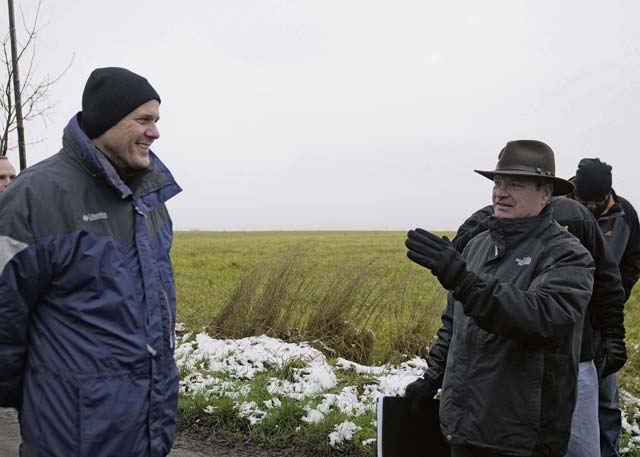
Dr. Ernest Roth (right), a Ph.D. holder in military history, discusses a specific battle from the Siege of Bastogne at the site of the battle with senior leaders of the 21st Theater Sustainment Command during a staff ride Dec. 5. Senior leaders of the 21st TSC participated in the staff ride to learn the history of the Siege of Bastogne from the Battle of the Bulge, apply lessons learned from past battles to use in current application, and build esprit de corps among the participants.
For the senior leaders of the 21st Theater Sustainment Command, gaining a better understanding of the conflicts of the past can help shape the way they conduct operations in the future.
On Dec. 5, Maj. Gen. John R. O’Connor, commanding general of the 21st TSC, gave his senior staff the opportunity to conduct an in-depth study of the Siege of Bastogne, a major campaign from the Battle of the Bulge, during a staff ride to Bastogne, Belgium.
The staff ride gave leaders the opportunity to develop and learn firsthand the details of the battle in order to apply lessons learned from past battles to use in current application, as well as build esprit de corps.
“When it comes to the Army, leader development is one of the main things we have to look at,” said Col. Matthew Redding, 21st TSC chief of staff. “In this case, we were studying a battle where small unit leaders led Soldiers against incredible odds. From that historic action, we wanted to focus on what it took to be a good leader, what it took to be a good Soldier, the battlefield conditions, the terrain and the enemy — many of the things we still study today in a professional Army.”
Participants started a day earlier with an in-depth analysis of the conflict from Dr. Ernest Roth, a Ph.D. holder in military history, and Capt. Michael Ellis, the 21st TSC’s G2 plans officer in charge, who discussed in full detail the path leading up to and the siege itself through detailed analysis.
“The purpose of the staff ride is twofold,” said Roth, who is also a retired sergeant major. “The first was a team building exercise for the command and staff, and the second was to improve people’s overall knowledge of the battle in and around Bastogne.”
The staff ride began with a stop in Clervaux, Luxemburg, the site where Soldiers with the 110th Regiment of the 28th Infantry Division, along with support from a company from the 9th Armored Division, held off the advancing German army while outnumbered, giving units from the 101st Airborne Division a chance to reach Bastogne before the Germans.
Some of the other stops made during the staff ride included a visit to Longvilly, Belgium, the site of another confrontation between Americans and Germans prior to the German’s arrival outside of Bastogne, before visiting the sites of other famous battles around the city.
One of the most intriguing stops along the way was to the site where paratroopers with Easy Company, 2nd Battalion, 506th Parachute Infantry Regiment, 101st Airborne Division made their famous stand against the German army to the east of Bastogne. In the woods, along the road, participants were able to see the individual fighting positions, still present 70 years later.
Roth said he hopes the staff ride gave participants an appreciation of the sacrifices made by so many Soldiers who fought in the Battle of the Bulge and in Bastogne.
“Mission command is certainly an important takeaway from any staff ride,” he said. “But a nice intangible is the fact that we are an honorable profession, and we are the descendants of the honorable men who fought here.”
Before boarding the busses and heading back home after a day of gaining a better understanding of the battle, the day’s activities concluded with a visit to the Bastogne War Museum and the site of the massive Mardasson Memorial, honoring the memory of 76,890 American Soldiers who were wounded or killed during the Battle of the Bulge.
“Sessions like today’s staff ride are absolutely important,” O’Connor said to his staff during the trip. “It gives us perspective on what we do, why we do it, and when called upon, do it right.”


